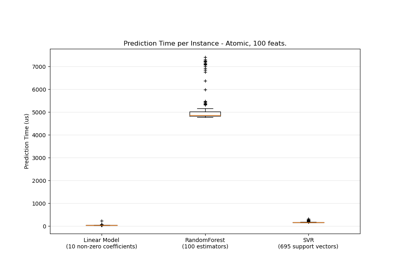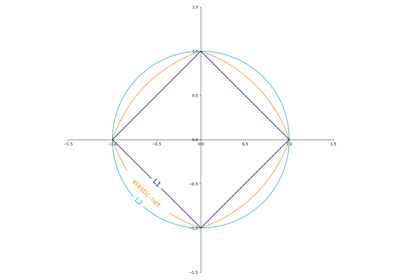sklearn.linear_model.SGDRegressor¶
-
class
sklearn.linear_model.SGDRegressor(loss='squared_loss', *, penalty='l2', alpha=0.0001, l1_ratio=0.15, fit_intercept=True, max_iter=1000, tol=0.001, shuffle=True, verbose=0, epsilon=0.1, random_state=None, learning_rate='invscaling', eta0=0.01, power_t=0.25, early_stopping=False, validation_fraction=0.1, n_iter_no_change=5, warm_start=False, average=False)[source]¶ Linear model fitted by minimizing a regularized empirical loss with SGD
SGD stands for Stochastic Gradient Descent: the gradient of the loss is estimated each sample at a time and the model is updated along the way with a decreasing strength schedule (aka learning rate).
The regularizer is a penalty added to the loss function that shrinks model parameters towards the zero vector using either the squared euclidean norm L2 or the absolute norm L1 or a combination of both (Elastic Net). If the parameter update crosses the 0.0 value because of the regularizer, the update is truncated to 0.0 to allow for learning sparse models and achieve online feature selection.
This implementation works with data represented as dense numpy arrays of floating point values for the features.
Read more in the User Guide.
- Parameters
- lossstr, default=’squared_loss’
The loss function to be used. The possible values are ‘squared_loss’, ‘huber’, ‘epsilon_insensitive’, or ‘squared_epsilon_insensitive’
The ‘squared_loss’ refers to the ordinary least squares fit. ‘huber’ modifies ‘squared_loss’ to focus less on getting outliers correct by switching from squared to linear loss past a distance of epsilon. ‘epsilon_insensitive’ ignores errors less than epsilon and is linear past that; this is the loss function used in SVR. ‘squared_epsilon_insensitive’ is the same but becomes squared loss past a tolerance of epsilon.
More details about the losses formulas can be found in the User Guide.
- penalty{‘l2’, ‘l1’, ‘elasticnet’}, default=’l2’
The penalty (aka regularization term) to be used. Defaults to ‘l2’ which is the standard regularizer for linear SVM models. ‘l1’ and ‘elasticnet’ might bring sparsity to the model (feature selection) not achievable with ‘l2’.
- alphafloat, default=0.0001
Constant that multiplies the regularization term. The higher the value, the stronger the regularization. Also used to compute the learning rate when set to
learning_rateis set to ‘optimal’.- l1_ratiofloat, default=0.15
The Elastic Net mixing parameter, with 0 <= l1_ratio <= 1. l1_ratio=0 corresponds to L2 penalty, l1_ratio=1 to L1. Only used if
penaltyis ‘elasticnet’.- fit_interceptbool, default=True
Whether the intercept should be estimated or not. If False, the data is assumed to be already centered.
- max_iterint, default=1000
The maximum number of passes over the training data (aka epochs). It only impacts the behavior in the
fitmethod, and not thepartial_fitmethod.New in version 0.19.
- tolfloat, default=1e-3
The stopping criterion. If it is not None, training will stop when (loss > best_loss - tol) for
n_iter_no_changeconsecutive epochs.New in version 0.19.
- shufflebool, default=True
Whether or not the training data should be shuffled after each epoch.
- verboseint, default=0
The verbosity level.
- epsilonfloat, default=0.1
Epsilon in the epsilon-insensitive loss functions; only if
lossis ‘huber’, ‘epsilon_insensitive’, or ‘squared_epsilon_insensitive’. For ‘huber’, determines the threshold at which it becomes less important to get the prediction exactly right. For epsilon-insensitive, any differences between the current prediction and the correct label are ignored if they are less than this threshold.- random_stateint, RandomState instance, default=None
Used for shuffling the data, when
shuffleis set toTrue. Pass an int for reproducible output across multiple function calls. See Glossary.- learning_ratestring, default=’invscaling’
The learning rate schedule:
‘constant’:
eta = eta0‘optimal’:
eta = 1.0 / (alpha * (t + t0))where t0 is chosen by a heuristic proposed by Leon Bottou.‘invscaling’:
eta = eta0 / pow(t, power_t)‘adaptive’: eta = eta0, as long as the training keeps decreasing. Each time n_iter_no_change consecutive epochs fail to decrease the training loss by tol or fail to increase validation score by tol if early_stopping is True, the current learning rate is divided by 5.
New in version 0.20: Added ‘adaptive’ option
- eta0double, default=0.01
The initial learning rate for the ‘constant’, ‘invscaling’ or ‘adaptive’ schedules. The default value is 0.01.
- power_tdouble, default=0.25
The exponent for inverse scaling learning rate.
- early_stoppingbool, default=False
Whether to use early stopping to terminate training when validation score is not improving. If set to True, it will automatically set aside a fraction of training data as validation and terminate training when validation score returned by the
scoremethod is not improving by at leasttolforn_iter_no_changeconsecutive epochs.New in version 0.20: Added ‘early_stopping’ option
- validation_fractionfloat, default=0.1
The proportion of training data to set aside as validation set for early stopping. Must be between 0 and 1. Only used if
early_stoppingis True.New in version 0.20: Added ‘validation_fraction’ option
- n_iter_no_changeint, default=5
Number of iterations with no improvement to wait before early stopping.
New in version 0.20: Added ‘n_iter_no_change’ option
- warm_startbool, default=False
When set to True, reuse the solution of the previous call to fit as initialization, otherwise, just erase the previous solution. See the Glossary.
Repeatedly calling fit or partial_fit when warm_start is True can result in a different solution than when calling fit a single time because of the way the data is shuffled. If a dynamic learning rate is used, the learning rate is adapted depending on the number of samples already seen. Calling
fitresets this counter, whilepartial_fitwill result in increasing the existing counter.- averagebool or int, default=False
When set to True, computes the averaged SGD weights accross all updates and stores the result in the
coef_attribute. If set to an int greater than 1, averaging will begin once the total number of samples seen reachesaverage. Soaverage=10will begin averaging after seeing 10 samples.
- Attributes
- coef_ndarray of shape (n_features,)
Weights assigned to the features.
- intercept_ndarray of shape (1,)
The intercept term.
- average_coef_ndarray of shape (n_features,)
Averaged weights assigned to the features. Only available if
average=True.Deprecated since version 0.23: Attribute
average_coef_was deprecated in version 0.23 and will be removed in 0.25.- average_intercept_ndarray of shape (1,)
The averaged intercept term. Only available if
average=True.Deprecated since version 0.23: Attribute
average_intercept_was deprecated in version 0.23 and will be removed in 0.25.- n_iter_int
The actual number of iterations before reaching the stopping criterion.
- t_int
Number of weight updates performed during training. Same as
(n_iter_ * n_samples).
See also
Examples
>>> import numpy as np >>> from sklearn.linear_model import SGDRegressor >>> from sklearn.pipeline import make_pipeline >>> from sklearn.preprocessing import StandardScaler >>> n_samples, n_features = 10, 5 >>> rng = np.random.RandomState(0) >>> y = rng.randn(n_samples) >>> X = rng.randn(n_samples, n_features) >>> # Always scale the input. The most convenient way is to use a pipeline. >>> reg = make_pipeline(StandardScaler(), ... SGDRegressor(max_iter=1000, tol=1e-3)) >>> reg.fit(X, y) Pipeline(steps=[('standardscaler', StandardScaler()), ('sgdregressor', SGDRegressor())])
Methods
densify()Convert coefficient matrix to dense array format.
fit(X, y[, coef_init, intercept_init, …])Fit linear model with Stochastic Gradient Descent.
get_params([deep])Get parameters for this estimator.
partial_fit(X, y[, sample_weight])Perform one epoch of stochastic gradient descent on given samples.
predict(X)Predict using the linear model
score(X, y[, sample_weight])Return the coefficient of determination R^2 of the prediction.
set_params(**kwargs)Set and validate the parameters of estimator.
sparsify()Convert coefficient matrix to sparse format.
-
__init__(loss='squared_loss', *, penalty='l2', alpha=0.0001, l1_ratio=0.15, fit_intercept=True, max_iter=1000, tol=0.001, shuffle=True, verbose=0, epsilon=0.1, random_state=None, learning_rate='invscaling', eta0=0.01, power_t=0.25, early_stopping=False, validation_fraction=0.1, n_iter_no_change=5, warm_start=False, average=False)[source]¶ Initialize self. See help(type(self)) for accurate signature.
-
densify()[source]¶ Convert coefficient matrix to dense array format.
Converts the
coef_member (back) to a numpy.ndarray. This is the default format ofcoef_and is required for fitting, so calling this method is only required on models that have previously been sparsified; otherwise, it is a no-op.- Returns
- self
Fitted estimator.
-
fit(X, y, coef_init=None, intercept_init=None, sample_weight=None)[source]¶ Fit linear model with Stochastic Gradient Descent.
- Parameters
- X{array-like, sparse matrix}, shape (n_samples, n_features)
Training data
- yndarray of shape (n_samples,)
Target values
- coef_initndarray of shape (n_features,), default=None
The initial coefficients to warm-start the optimization.
- intercept_initndarray of shape (1,), default=None
The initial intercept to warm-start the optimization.
- sample_weightarray-like, shape (n_samples,), default=None
Weights applied to individual samples (1. for unweighted).
- Returns
- selfreturns an instance of self.
-
get_params(deep=True)[source]¶ Get parameters for this estimator.
- Parameters
- deepbool, default=True
If True, will return the parameters for this estimator and contained subobjects that are estimators.
- Returns
- paramsmapping of string to any
Parameter names mapped to their values.
-
partial_fit(X, y, sample_weight=None)[source]¶ Perform one epoch of stochastic gradient descent on given samples.
Internally, this method uses
max_iter = 1. Therefore, it is not guaranteed that a minimum of the cost function is reached after calling it once. Matters such as objective convergence and early stopping should be handled by the user.- Parameters
- X{array-like, sparse matrix}, shape (n_samples, n_features)
Subset of training data
- ynumpy array of shape (n_samples,)
Subset of target values
- sample_weightarray-like, shape (n_samples,), default=None
Weights applied to individual samples. If not provided, uniform weights are assumed.
- Returns
- selfreturns an instance of self.
-
predict(X)[source]¶ Predict using the linear model
- Parameters
- X{array-like, sparse matrix}, shape (n_samples, n_features)
- Returns
- ndarray of shape (n_samples,)
Predicted target values per element in X.
-
score(X, y, sample_weight=None)[source]¶ Return the coefficient of determination R^2 of the prediction.
The coefficient R^2 is defined as (1 - u/v), where u is the residual sum of squares ((y_true - y_pred) ** 2).sum() and v is the total sum of squares ((y_true - y_true.mean()) ** 2).sum(). The best possible score is 1.0 and it can be negative (because the model can be arbitrarily worse). A constant model that always predicts the expected value of y, disregarding the input features, would get a R^2 score of 0.0.
- Parameters
- Xarray-like of shape (n_samples, n_features)
Test samples. For some estimators this may be a precomputed kernel matrix or a list of generic objects instead, shape = (n_samples, n_samples_fitted), where n_samples_fitted is the number of samples used in the fitting for the estimator.
- yarray-like of shape (n_samples,) or (n_samples, n_outputs)
True values for X.
- sample_weightarray-like of shape (n_samples,), default=None
Sample weights.
- Returns
- scorefloat
R^2 of self.predict(X) wrt. y.
Notes
The R2 score used when calling
scoreon a regressor usesmultioutput='uniform_average'from version 0.23 to keep consistent with default value ofr2_score. This influences thescoremethod of all the multioutput regressors (except forMultiOutputRegressor).
-
set_params(**kwargs)[source]¶ Set and validate the parameters of estimator.
- Parameters
- **kwargsdict
Estimator parameters.
- Returns
- selfobject
Estimator instance.
-
sparsify()[source]¶ Convert coefficient matrix to sparse format.
Converts the
coef_member to a scipy.sparse matrix, which for L1-regularized models can be much more memory- and storage-efficient than the usual numpy.ndarray representation.The
intercept_member is not converted.- Returns
- self
Fitted estimator.
Notes
For non-sparse models, i.e. when there are not many zeros in
coef_, this may actually increase memory usage, so use this method with care. A rule of thumb is that the number of zero elements, which can be computed with(coef_ == 0).sum(), must be more than 50% for this to provide significant benefits.After calling this method, further fitting with the partial_fit method (if any) will not work until you call densify.


